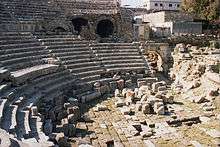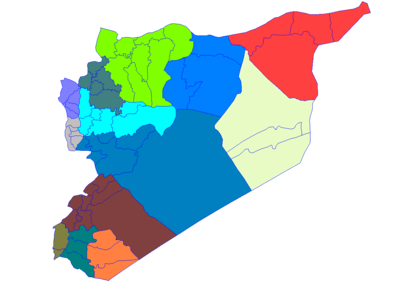Jableh
Jableh (Arabic: جبلة; Ǧabla, also spelt Jebleh, Jabala, Jablah, Gabala or Gibellum) is a coastal city on the Mediterranean in Syria,[1] 25 km (16 mi) north of Baniyas and 25 km (16 mi) south of Latakia, with c. 80,000 inhabitants (2008). As Ancient Gabala it was a Byzantine (arch)bishopric and remains a Latin Catholic titular see. It contains the tomb and mosque of Ibrahim Bin Adham, a legendary Sufi mystic who renounced his throne of Balkh and devoted himself to prayers for the rest of his life.[2]
Jableh جبلة | |
|---|---|
 A collage of Jableh. | |
| Nickname(s): جبلة الروح | |
 Jableh Location in Syria | |
| Coordinates: 35°21′N 35°55′E | |
| Country | Syria |
| Governorate | Latakia |
| District | Jableh |
| Subdistrict | Jableh |
| Elevation | 16 m (52 ft) |
| Population | |
| • Total | 80,000 |
| Demonym(s) | Arabic: جبلاوي, romanized: Jablawi |
| Time zone | UTC+2 (EET) |
| • Summer (DST) | UTC+3 (EEST) |
| Geocode | C3585 |
History

Jableh has been inhabited since at least the second millennium BCE.[3] The city was part of the Ugaritic kingdom and was mentioned as "Gbʿly" in the archives of the city c. 1200 BC.[4] In antiquity Jableh (then called Gabala) was an important Hellenistic and then Roman city. One of the main remains of this period is a theatre, capable of housing c. 7,000 spectators. Near the seashores even older remains were found dating to the Iron Age or Phoenician Era.
In the medieval period, Jableh was part of the Principality of Antioch, one of the Crusader States, until it was captured by Saladin in 1189 during the Third Crusade. One famous resident was Hugh of Jabala, the city's bishop, who reported the fall of Edessa to Pope Eugene III, and was the first person to speak of Prester John.
Less than 1 kilometer from the city centre lies the ancient site of Gibala, today known as Tell Tweini. This city was inhabited from the third millennium BCE until the Persian period.
On May 23, 2016, the Islamic State of Iraq and the Levant claimed responsibility for four suicide bombings in Jableh, which had remained largely unaffected since the Syrian Civil War began in 2011. Purportedly targeting Alawite gatherings, the bombs killed over a hundred people. In Tartus, similarly insulated, another three bombers killed 48 people.[5]
Economy
The majority of people in Jableh depend on agriculture for their life, people grow orange and lemon trees, olives, a large number of green houses for vegetables can be found in the country side. In the center of the city people work in trade and there are small factories in the city for cottons and for making orange juice.
Notable locals
- Syrian pioneer of modern Arabic poetry Adunis.
- Izz ad-Din al-Qassam, a famous Islamic figure who fought against the French Colonization in Syria, and then moved to Palestine where he led an armed rebellion against the British authorities and Jewish colonists.
Mohammad Zaytoon, the worldwide swimming championship for several consecutive years.
Sports
Jableh Sporting Club is a football (soccer) club based in Jableh, playing in the Al-Baath Stadium, which has a seating capacity of 10,000.
Climate
Jableh has a hot-summer Mediterranean climate (Köppen climate classification Csa).
| Climate data for Jableh | |||||||||||||
|---|---|---|---|---|---|---|---|---|---|---|---|---|---|
| Month | Jan | Feb | Mar | Apr | May | Jun | Jul | Aug | Sep | Oct | Nov | Dec | Year |
| Average high °C (°F) | 12.8 (55.0) |
14.0 (57.2) |
17.7 (63.9) |
21.4 (70.5) |
25.0 (77.0) |
28.3 (82.9) |
30.0 (86.0) |
28.8 (83.8) |
27.6 (81.7) |
26.5 (79.7) |
21.5 (70.7) |
15.5 (59.9) |
22.4 (72.4) |
| Daily mean °C (°F) | 10.1 (50.2) |
10.9 (51.6) |
13.8 (56.8) |
16.9 (62.4) |
20.3 (68.5) |
23.9 (75.0) |
26.1 (79.0) |
25.6 (78.1) |
23.7 (74.7) |
21.6 (70.9) |
16.9 (62.4) |
12.2 (54.0) |
18.5 (65.3) |
| Average low °C (°F) | 7.3 (45.1) |
7.8 (46.0) |
9.9 (49.8) |
12.4 (54.3) |
15.5 (59.9) |
19.4 (66.9) |
22.2 (72.0) |
22.3 (72.1) |
19.8 (67.6) |
16.7 (62.1) |
12.3 (54.1) |
8.9 (48.0) |
14.5 (58.2) |
| Average precipitation mm (inches) | 159 (6.3) |
130 (5.1) |
109 (4.3) |
50 (2.0) |
28 (1.1) |
4 (0.2) |
1 (0.0) |
1 (0.0) |
15 (0.6) |
52 (2.0) |
89 (3.5) |
190 (7.5) |
828 (32.6) |
| Average rainy days (≥ 1 mm) | 14 | 12 | 11 | 8 | 4 | 1 | 1 | 1 | 2 | 6 | 9 | 12 | 81 |
| Source 1: http://www.worldweatheronline.com/jableh-weather-averages/al-ladhiqiyah/sy.aspx | |||||||||||||
| Source 2: http://en.climate-data.org/location/47687/ | |||||||||||||
References
- "Gabala". Catholic Encyclopedia.
- Google Books Travels In Asia And Africa, 1325-54 By Battuta Ibn, Ibn Batuta Translated by Sir Hamilton Gibb (1996) ISBN 81-206-0809-7 p. 62
- Esber, Hawazan. "Small historical coastal cities: Urban development and freshwater resources". NESCO. Retrieved 11 August 2015.
- William A. Ward, Martha Joukowsky (1992). The Crisis years: the 12th century B.C. : from beyond the Danube to the Tigris. p. 113.
- "IS blasts in Syria regime heartland kill more than 148", by AFP, via Channel NewsAsia
